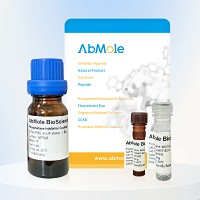All AbMole products are for research use only, cannot be used for human consumption.

CD137 (also known as 4-1BB) is an inducible cell surface receptor, a member of the tumornecrosis factor receptor (TNFR) superfamily. It is encoded by tumor necrosis factor receptor superfamily member 9 (TNFRSF9) gene. It is widely expressed on the surface of activated T cells, NK cells and other human immune cells. Its ligand is CD137L, also a member of TNFSF, and is an inducible costimulatory receptor expressed on activated CD4+ and CD8+ T cells, NKT, NK cells, DC, macrophages, eosinophils, neutrophils, and mast cells, especially on CD8+ T cells. CD137/CD137L modulates T cell-mediated immune responses by transmitting activation, proliferation, or apoptosis signals between immune cells. Activated signal transduction of CD137 stimulates NK and T cell proliferation and produces antitumor activity, as well as long-lasting memory responses. Activated 4-1BB mab was used to activate 4-1BB, which recruited TNFR-related factors TRAF1 and TRAF2 to form heterotrimers. Signal transduction was enhanced through C-Jun N-terminal kinase (JNK) pathway and extracellular signal-regulated kinase (ERK) pathway. The main transcription factor NF-κB regulates the 4-1BB signal, stimulates T cells and antigen presenting cells to proliferate and secrete cytokines, and improves the level of anti-tumor immune response.
Expression host: HEK-293 cells
Purity: > 95%
Endotoxin: < 0.1EU/μg
| Form | Liquid |
| Storage | Stored at 2~8°C, stable for one year after receipt. After divided, stored at -20°C for 6 months and at -80°C for 12 months. |
| Related Cytokines and Growth Factors Products |
|---|
| Recombinant Human GDF-15 Protein (HEK293 N-hFc)
Growth-differentiation factor 15 (GDF15), also known as MIC-1, is a secreted member of the transforming growth factor (TGF)-β superfamily. GDF-15 has a role in regulating inflammatory and apoptotic pathways in injured tissues and during disease processes. GDF-15 overexpression arising from an expanded erythroid compartment contributes to iron overload in thalassemia syndromes by inhibiting hepcidin expression. |
| Recombinant Human FGFR1 Protein (HEK293, C-His)
FGFR1, also known as CD331, is a full-length representative protein consists of an extracellular region, composed of three immunoglobulin-like domains, a single hydrophobic membrane-spanning segment and a cytoplasmic tyrosine kinase domain. |
| Recombinant Human FGFR2 Protein (HEK293, C-His)
FGFR2, also known as CD332, acts as cell-surface receptor for fibroblast growth factors and plays an essential role in the regulation of cell proliferation, differentiation, migration and apoptosis, and in the regulation of embryonic development. FGFR2 plays an essential role in the regulation of osteoblast differentiation, proliferation and apoptosis, and is required for normal skeleton development. It also promotes cell proliferation in keratinocytes and imature osteoblasts, but promotes apoptosis in differentiated osteoblasts. |
| Recombinant Mouse BMP-4 Protein (E. coli, C-His)
Bone Morphogenetic Protein-4 (BMP-4) is a critical signaling molecule required for the early differentiation of the embryo and establishing of a dorsal-ventral axis. BMP-4 is secreted from the dorsal portion of the notochord, and it acts in concert with sonic hedgehog to establish a dorsal-ventral axis for the differentiation of later structures. |
| Recombinant Human Coagulation Factor X (HEK293, C-Fc)
Coagulation factor X, belongs to the peptidase S1 family. Coagulation factor X is initially synthesized in the liver. Coagulation factor X is a vitamin K-dependent glycoprotein that converts prothrombin to thrombin in the presence of factor Va, calcium and phospholipid during blood clotting. |
All AbMole products are for research use only, cannot be used for human consumption or veterinary use. We do not provide products or services to individuals. Please comply with the intended use and do not use AbMole products for any other purpose.


Products are for research use only. Not for human use. We do not sell to patients.
© Copyright 2010-2024 AbMole BioScience. All Rights Reserved.
